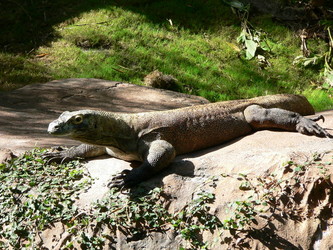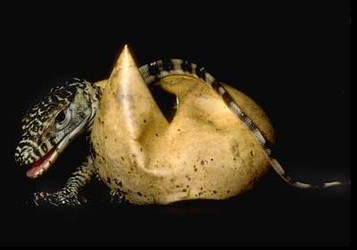


Varanus komodoensis. Left: captive at Chester Zoo, England, © Nicholas Hinks. Right: captive at Disney's Animal Kingdom, © Raul654.
Introduction
Varanus komodoensis is the largest extant lizard on Earth and is endemic to several small islands in Indonesia. The genus name, Varanus is the latinization of the Arabic word "waran" which stands for monitor (Egyptians believed these lizards served as monitors, alerting people to the presence of crocodiles). Its common names include the "Komodo dragon" (Komodo is one of the islands they are found on), "ora" which means land crocodile in the Mangarrai dialect, and Komodo monitor.
History and Evolution
V. komodoensis share a common ancestor with dinosaurs, but do not descend from them. Both V. komodoensis and dinosaurs belong to the subclass Diapsida which is branched into two infraclasses: Archosauria (dinosaurs, including birds) and Lepidosauria (tuataras, lizards, and snakes). Fossil records show that around 100 million years ago, during the Cretaceous period, a species related to the present-day Varanidae appeared and reached Australia by about 15 million years ago. From this species descended a second lineage which differentiated into V. komodoensis about 4 million years ago.
There has been much debate about how V. komodoensis evolved to be as large as it is, despite being isolated on small islands with limited resources. One theory suggests that the presence of pigmy elephants or stegodonts selected for larger dragons. The larger the dragon, the more capable it is of hunting large prey such as pigmy elephants.
Discovery
The Komodo dragon was first documented in 1910 by Lieutenant van Steyn van Hensbroek who went to Komodo Island after hearing stories about giant lizards. He killed a dragon and sent the skin and several photographs to Peter A. Ouwens, director of the Zoological Museum and Botanical Garden at Bogor, Java, who eventually determined that the dragon was a monitor lizard. Several expeditions followed including an expedition led by W. Douglas Burden which captured 27 specimens and examined at least 70 individuals in 1926.
Physical Characteristics
The Komodo dragon is the world's largest extant lizard at an average length of 2.6 m and an average weight of 40-70 kg. The dragons have sharp, curved claws and around 60 curved, serrated teeth with 4-5 replacement teeth at each position. The serrations in the teeth help Komodos tear large prey into smaller pieces. Bits of meat from their meals get caught between their teeth and the decay of these pieces promotes the growth of several highly septic bacteria. The bacteria often cause the death of the prey by infection so even if the prey has escaped initially, if it has been bitten, it may end up as a Komodo's meal. Komodo dragons are resistent to these bacteria, so a bite from another dragon would not cause death by infection.
Colouration
- adults are grey or clay coloured; young are more colourful, with brighter, speckled skin
- females and males are similarly coloured although females have more red on their flanks
- the yellow, forked tongue is specific to V. komodoensis
Smell
- primary food detector; can detect carrion from as far as 5 km away
- scent particles from the air are collected by the forked tongue and brought to the roof of the mouth (Jacobson's organs) where signals are generated and sent to the brain
Vision
- retinas possess only cone cells which can detect colour but are weak in dim light
- can see as far as 300 m
- is useful in hunting to detect motion
Hearing
- komodos are not deaf, but they do not rely on sound as much as smell
- can only hear a small range of frequencies
Habitat
V. komodoensis are found naturally on the islands of Komodo, Flores, Rinca, and Gilli Motang in the middle of the Lesser Sunda Islands in Indonesia. All of these islands are volcanic. There are two main seasons in the Lesser Sunda Islands: a moderate monsoon season (January to March), and a long dry season. V. komodoensis are usually found in rocky valleys between 500-700m above sea level and frequently occupy regions between the tropical monsoon forest and the savanna. Hatchlings live in trees and feed on insects and smaller mammals, but medium to larger dragons live on the ground.
Behavior
Komodo dragons are ectotherms and thus require a lot less food than mammals of similar size. They dig dens to protect themselves from the heat of the sun and often dig in search of rodents, lizards, and snakes for food. Digging is done using the fore legs: one leg digs several strokes and then the other.
Rubbing behavior is often practiced by young Komodo dragons. They rub their bodies in the hair or intestinal contents of carrion. It is thought that being covered in feces would protect them from predation by larger dragons.
Feeding
- they are scavengers and predators (eat both carrion and live meat)
- hatchlings feed exclusively on insects
- small to medium Komodo dragons eat smaller lizards, rodents, birds, and eggs
- large dragons eat carrion or hunt animals: wild board, deer, water buffalo, large snakes, and smaller Komodos
- hunt by stealth and patience rather than by chasing down their prey
- once a prey is spotted, a dragon would move in until they are around 1 m away from their prey. The jaws close rapidly and the prey is held (or thrashed) until all movement ceases. Smaller prey are swallowed whole, but larger prey are sliced and devoured.
- ingestion rate could be as much as 2.5kg/min
- have high digestion efficiency (70-90%)
Locomotion
- quadrupedal
- normal speed around 4.8 km/hr but can run up to 14-20 km/hr over short distances
- when walking, the head, body, and tail sway side to side
- when running, the tail is held off the ground and the hind feet move in a wide lateral arc
- are strong swimmers
- young dragons are good climbers but lose their skill has they get older and heavier
Communication
- they are solitary animals; they gather occasionally around carrion and meet only to reproduce
- exhibit minimal (if any) territorial behaviour
- dominance is based on size, and sex and determines position at feeding sites
- no sexual displays, but aggregate for mating and establishing hierarchies
- threat displays include hissing, tail lashing, gaping mouth, arched back
- hissing: a defensive behavior during feeding and attacks and often used by females during mating
- fighting in males often results in severe cuts and death
Reproduction and Life Cycle
Courtship and Mating
- occurs between May and August
- sexual maturity for both males and females is 5-7 years
- dominant males fight by rising up on hind legs, using theirs tails as support, and grabbing at the other male with their fore legs
- courtship is very brief
- females often attack males during the early phases of courtship
- sex ratio in wild is 3 males:1 female

The hatching of Kraken in 1992. Kraken was the first Komodo dragon born outside of Indonesia. Photo by Jessie Cohen, © Smithsonian Institution.
Nesting
- females lay an average of 18 eggs in a burrow in the ground over several days in September
- females clutch once a year
- eggs have soft, leathery shell and incubate for 2.5-8 months
- hatchlings appear in April or May and weigh about 80 g
- no evidence of parental care
Development
- not many young survive to adulthood, and they often fall victim to many predators
- if they survive until 5 years old, they can reach up to 2.5 m long and weigh 25 kg
- they live up to 25 years in captivity; Auffenberg estimates a lifespan of 50 years in the wild
Parthenogenesis (Virgin Birth)
- offspring resulting from parthenogenesis are all male
- use the ZW sex-determination system in which males are ZZ and females are ZW
- the female provides her progeny with a haploid set of chromosomes (and only one sex chromosome: Z or W)
- the haploid set is replicated and eggs that receive a Z chromosome become ZZ (male) and develop. Eggs that receive W become WW and fail to develop
Information on the Internet
- Reptiles: Komodo Dragon San Diego Zoo.
- Komodo Dragon Biogeography Jung, Craig. 20 May 1999. San Francisco State University.
- Ora: Varanus komodoensis American Museum of National History. 1996.
- Virgin Births' for Giant Lizards BBC News. 20 Dec. 2006.
- 2006 IUCN Red List of Threatened Species World Conservation Monitoring Centre. 2006 IUCN Red List of Threatened Species.




 Go to quick links
Go to quick search
Go to navigation for this section of the ToL site
Go to detailed links for the ToL site
Go to quick links
Go to quick search
Go to navigation for this section of the ToL site
Go to detailed links for the ToL site